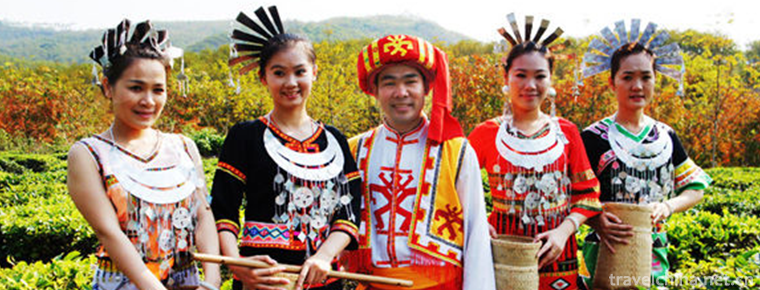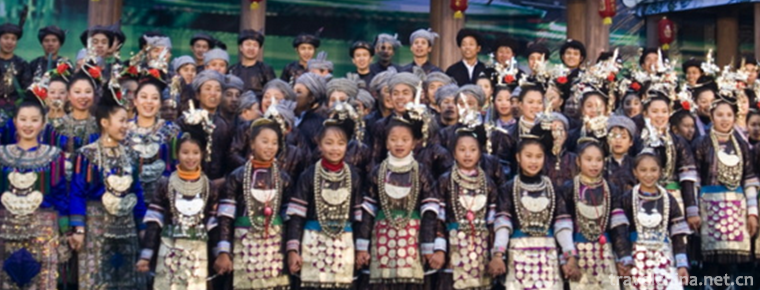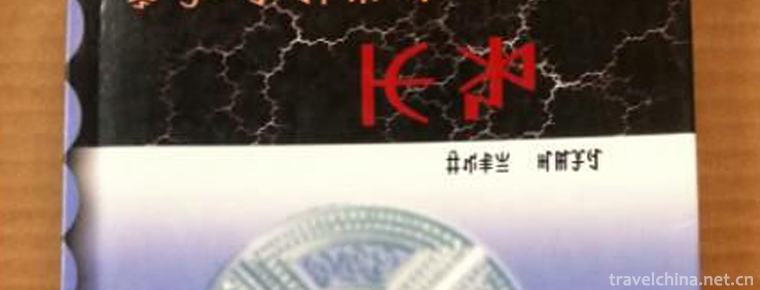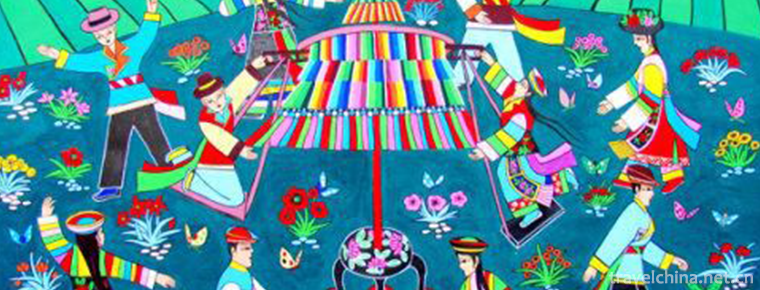Li nationality costumes
Li nationality costumes
Li costumes are mainly made of island cotton, hemp, kapok, bark fiber and silk. In ancient times, some places also used the bark of twig or bloody throat trees as clothing materials. This kind of dress material is made by cutting down the bark from the hill, removing the outer layer of skin residue by beating, leaving the fiber layer, and then soaking and drying with purple cabbage (ash burned from the shell).
Li men usually wear a pair of collarless jacket and trousers, and tie their headscarves to insert pheasant feathers. Women wear black round-collar headdress with many ornaments. The neckline is connected with white and green beads into three sets of edges. The cuffs and hems are decorated with patterns. The front and back are strung with beads in a color pattern. Wear a tight miniskirt underneath. Some wear black and blue flat-collar jackets, white embroidered cuffs, a stripe pattern on the back, a colorful flower dress with folds at the front, silver chains at the head, silver necklaces at the neck, pearl bells at the chest, and silver rings at the hands. The head is tied with a black cloth scarf.
The Li costumes declared by Hainan Jinxiu Zhibei Co., Ltd. on June 14, 2008 were listed in the second batch of national intangible cultural heritage list with the approval of the State Council. (Category: Folklore; Number: _-111)
Historical evolution
Overview
The traditional costumes of Li nationality are brilliant and colorful, and their styles and patterns have local characteristics.
Ancient
Historically, Li women in Hainan Island were skilled in textiles, dyeing and embroidery. They used island cotton, kapok, bark fiber and silk to sew clothes.
Shangshu Yugong records that "island Yihua clothes, pole weaving shellfish" refers to the situation of textiles. The Han Dynasty has "wide distribution", the Tang Dynasty has "Jibeibu", "Panban cloth", "food list" (tablecloth), to the Song Dynasty has "blue and white cloth" and so on. In Book of the Later Han Dynasty, Volume 86, Biographies of Nanman, it is recorded that at the end of Emperor Wu, Sun Xing, a member of the Zhuya Taishou Association, spread his works in a wide range, and was unable to serve, so he attacked the county and killed the fortune.
” In the middle of Tang Dynasty, Li women woven quilts, tablecloths and dish patches with "Jibei" (wild kapok) and were listed as tributes of the court. After the Song Dynasty, the cotton textile skills of the Li nationality became more superb. The women of the Li nationality weaved delicate cotton fabrics such as "Li Jin", "Li Dan", "Li Curtain" and "Li Mantle", which were loved by the people of the Central Plains. There used to be "bark cloth" costumes in Li society. This dress material is made by cutting down the bark of the toon tree or the bloody throat tree on the hill, beating off the outer skin slag, leaving the fiber layer, and then soaking and drying with lime (ash burned from the shell). Li ancestors used this bark fiber to sew clothes, quilts, hats and so on.
Before the founding of the People's Republic of China, most Li costumes were self-spun, self-woven, self-dyed and self-sewn. Their dyes were made of mountain plants, supplemented by mineral dyes. The music history of the Song Dynasty, Taiping Huanyu Ji, Fan Chengda's Guihai Yuheng Zhi, Zhao Rushi's Zhufan Zhi and Zhou Qufei's Lingwai Dai Answer, all have records about the material of Li brocade. For example, "Guihai Yu Heng Zhi" Volume 15: "When the curtain rises in Lidong, Hainan, Li people get Chinese brocade collection, take out color silk, and weave kapok into a single scene with four pieces of kapok." In addition, Volume 6 of Ling Wai Dai Dai Answer reads: "Hainan knitted (Gibeb) is very tasteful! Extremely wide... Between five picks, different lines are shining! ______________ The "Li brocade", "Li dan" and "Li curtain" weaved by the Li people in Hainan are very popular in the Central Plains because of their bright colors, beautiful appearance and applicability.
There are many records about Li costumes in ancient books, such as Han Shu Volume 28 Geographic Records: "In the first year of Emperor Wu Yuanfeng, people slightly thought that Daner and Zhuya prefectures were all clothed, such as single quilt, running through the central government. Shi Gu said,'Write from the beginning to the end'. The women of Li nationality in Mobil dialect have traditional valerian dyeing technology. What Su Shi said in The Story of Junling King's Temple is "weaving flowers" referring to the Li nationality in Mobil dialect. This valerian dyeing method is to tie the pattern on the warp line, then dye, and then weave clothes.
In the course of frequent exchanges with various nationalities on the island, some changes have taken place in the costumes of the Li nationality. The most obvious one is to change the collarless straight jacket and through jacket into digging collar, or to change the straight body, straight seam and straight sleeve to make the waist and cuff seam (fold), or to change the buttonless to decorative button, and later to Pipa button, and finally to change the skirt to biased. The Li people in the Sai dialect, except those in Zuguan and Qunying areas of Lingshui Li Autonomous County, wear flower pots (commonly known as "silk pots"), the rest are embroidered on the skirt tail and waist, and then the jacket is decorated with brightly colored lace. The tube skirts are mostly laced with plaid patterns, and finally only wear blue dresses, black skirts or plain garments without flower patterns.
modern
After the liberation of Hainan in 1950, the costumes of Li nationality changed greatly. According to the social survey data of Li nationality in 1950s, the younger generation in the countryside at that time had generally accepted the Chinese dress, and the older men (over 40 years old) still had their own national coat, but they had changed to wear Chinese trousers or shorts instead of "eaves" (skirts with a piece of cloth hanging from front to back) and "egg wrapping cloth". Women's clothing has been changed from purchased cloth to blouses in terms of material. Dresses are still self-woven. Many people also wear all kinds of shirts and pants they buy. Only middle-aged and old women in remote areas still wear Li costumes. Since the 1980s, few people in Li society have worn ethnic costumes, and young girls in villages are not keen on brocade making ethnic costumes.
Li costumes retain strong national customs and costume characteristics. By 1990, although young men and women of Li nationality had changed into Han clothes in many places, they still wore traditional clothes on marriage, funeral, religious activities and festival days.


-
The Oriental Pearl Radio & TV Tower
The Oriental Pearl Radio and Television Tower is one of the landmark cultural landscapes in Shanghai. It is located in Lujiazui, Pudong New Area, with a height of 468 meters.
Views: 607 Time 2018-12-05 -
the Dong chorus
Originated in the Spring and Autumn Period and the Warring States Period, the Dong Grand Song has a history of more than 2500 years. It is a folk chorus form with multi-voice.
Views: 165 Time 2019-04-27 -
Roast duck skills
Quanjude hanging oven roast duck is a local traditional handicraft in Beijing. Quanjude Roast Duck Restaurant, a well-known old Chinese brand in Beijing, was founded in 1864 by Yang Quanren..
Views: 191 Time 2019-05-08 -
Mamuteyi Ma mu te yi
Mamuteyi, translated into Chinese as Education Classic, is the product of the slavery society of the Yi people in Liangshan. In the Yi language, "Ma" means education, instruction and persuas.
Views: 121 Time 2019-05-16 -
Shibao Mountain Song Club
The Bai Jianchuan Shibao Mountain Song Festival is held every year from 27 to 29 July of the lunar calendar for three days. At this time, tens of thousands of young Bai men and women and singers from .
Views: 181 Time 2019-06-15 -
Turkish Pan Embroidery
Pan embroidery is the most important embroidery method in Chinese Tu embroidery, and it is a compulsory course for Tu women in their lifetime. Pan embroidery is a unique embroidery method of the Tu na.
Views: 387 Time 2019-06-23 -
Beijing University of Civil Engineering and Architecture
Beijing Architectural University is a pilot University jointly constructed by Beijing and the Ministry of Housing and Urban-Rural Construction, the "Education and Training Plan for Excellent Engi.
Views: 136 Time 2019-09-06 -
Muli Temple
Muli temple is a key cultural relics protection unit in Sichuan Province. It is located at the foot of daniyabu mountain, youyidian village, Taoba Township, Muli Tibetan Autonomous County. It is more than 300 kilometers away from Xichang City.
Views: 274 Time 2020-10-16 -
Mineral resources in Neijiang
Neijiang City is rich in mineral resources. Energy minerals mainly include coal, natural gas and oil shale; nonmetal and building materials minerals include limestone, sandstone, shale, refractory clay, bauxite, marble, river sand, gravel and ceramic clay, etc.;.
Views: 347 Time 2020-12-16 -
Neijiang science and technology
In 2019, Neijiang City completed 195 science and technology projects above the municipal level, and applied for 2509 patents and obtained 1425 authorized patents, including 456 invention patents and 90 authorized invention patents. At the end of the year, there .
Views: 121 Time 2020-12-16 -
Leshan secondary industry
In 2019, the industrial added value of Leshan City is 68.028 billion yuan, an increase of 8.8% over the previous year, accounting for 36.5% of the city's GDP, driving economic growth by 4.0 percentage points and contributing 52.8% to economic growth..
Views: 360 Time 2020-12-17








